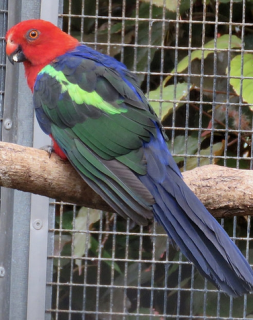Papuan King Parrot |
|
|
Also known as: Green-winged Parrot
Photos
View in GalleryDid You Know?
The king parrots are easily recognized as a group by their intensely coloured, shiny red, green and blue plumage and long tails.Academic Research
Related publications: Alisterus chloropterusSpecies Profile
Genus: Alisterus | Species: chloropterus
Size:
36cm (14 in)
Weight:
138-190g (4.8-6.6 oz)
Subspecies including nominate:
three: A.c. chloropterus, A.c. callopterus, A.c. moszkowskii
Colour Adult:
A.c. chloropterus: Male-red head and underparts; upper mantle black with blue band, extending to nape; folded wing has yellow/green blaze; rest of wing dark green; blue back, rump and upper tail coverts; black tail. Upper mandible orange/red tipped with black, grey/black lower mandible. Eye orange. Female-dull green head, back and wings; dull green throat and breast margined with red; dark green tail. Upper mandible orange/brown tipped with grey.
A.c. callopterus: Male-as in chloropterus, but blue band on mantle not extended to hindneck and nape. Female-as in chloropterus.
A.c. moszkowskii: Male-as in callopterus. Female-as in male.
Colour Juvenile:
A.c. chloropterus: As in adult female, but red on breast absent; lateral tail feathers tipped with dull pink. Eye brown.
A.c. moszkowskii: As in adult female.
Call:
Calls are described as shrill and metallic, repeated while in flight or alarmed. Also high-pitched, metallic upslurred notes while perched.
Listen NowVideo Links:
Video 1More Information:
Content Sources:
CITES
BirdLife International
Cornell Lab of Ornithology/Birds of the World
Parrots: A Guide to Parrots of the World, Juniper and Parr, 1998
ML Media Collection Catalogue 65913, Papuan King Parrot Alisterus chloropterus, Connop, Scott, Papua New Guinea, Oct. 8 1993, Cornell Lab of Ornithology. Site
Parrots of the World, Forshaw, 2006. 2010 edition
Lexicon of Parrots, Thomas Arndt.
Parrots in Aviculture, Low, 1992.
Photos
View in GalleryDid You Know?
The king parrots are easily recognized as a group by their intensely coloured, shiny red, green and blue plumage and long tails.Academic Research
Related publications: Alisterus chloropterusSpecies Care
Captive Status:
Rare
Longevity:
15-25 yrs
Housing:
Walk-in aviary, minimum length 4.5m (14.7 ft).
Diet:
Small seed mix such as: canary, oats, safflower and a little hemp; spray millet; limited sunflower seed, dry, soaked or sprouted; sprouted pulses such as mung beans, cooked butterbeans and lentils; boiled maize; green leaves such as: Swiss chard, lettuce, sowthistle, dandelion, chickweed; vegetables such as: fresh corn, carrot, celery, zucchini, squash, green beans and peas in the pods; fruits such as: apple, pear, orange, cactus fruits, pomegranate, banana, kiwi; nuts such as: lightly cracked hazelnuts, pecans and roasted peanuts; complete kibble.
Enrichment:
Not a vigorous chewer; provide ladders, swings, ropes and puzzle/foraging toys. Provide overhead misters or shallow water bowls for bathing.
Nest Box Size:
Nest log 10" (25.4cm) around and 4-5' (1.5-2m) deep.
Clutch Size:
3-4
Incubation Time:
21 days
Fledging Age:
8 weeks
Hatch Weight:
About 8-9g (0.3 oz)
Peak Weight:
Not recorded.
Weaning Weight:
Not recorded.
Photos
View in GalleryDid You Know?
The king parrots are easily recognized as a group by their intensely coloured, shiny red, green and blue plumage and long tails.Academic Research
Related publications: Alisterus chloropterusSpecies Wild Status
World Population:
Unknown, stable.
IUCN Red List Status:
Least Concern
CITES Listing:
Appendix II
Threat Summary:
Generally scarce and in low numbers, though locally common and probably underrecorded due to quiet behaviour. Over 3300 birds were reported in international trade during the period 1987 to 1992; quotas greatly reduced in mid-1990s.
Range:
A.c. chloropterus: E New Guinea.
A.c. callopterus: C New Guinea.
A.c. moszkowskii: N New Guinea.
Habitat:
Found up to 2600m (8528 ft) in dense forest, open areas with casuarinas, cultivated areas and secondary growth forest.
Wild Diet:
Takes Casuarina fruits, seeds, berries and nuts.
Ecology and Behaviour:
Seen singly, in pairs or groups of up to ten individuals. Are fairly approachable in wild. Quiet and inconspicuous while feeding in lower and middle canopy.
Clutch and Egg Size:
3-4 eggs
Breeding Season:
Begins in March.
Related Links:
Photos
View in GalleryDid You Know?
The king parrots are easily recognized as a group by their intensely coloured, shiny red, green and blue plumage and long tails.Academic Research
Related publications: Alisterus chloropterusMembers Only Resources
Please log-in now to find more research, resources and tools.
Not a Member?
Find more great information:
Gain exclusive access to 600+ pages of additional research, seminars and podcasts, specialists to ask your toughest questions, and dozens of other fun resources - when you become a WPT member.
Join Today >>

































